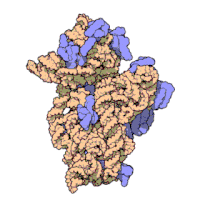
Photo from wikipedia
Analyses of the microbiome are increasingly important to understand the impact of the microbiota on physiological functions, diseases, and toxicity in the host organism. The microbiome is the sum of… Click to show full abstract
Analyses of the microbiome are increasingly important to understand the impact of the microbiota on physiological functions, diseases, and toxicity in the host organism. The microbiome is the sum of all bacteria, viruses, fungi, and phages forming communities present in any habitat, including human mucosal tissues, the gut, the lung, or the skin. The scientific literature dealing with microbiomes is a simple, yet impressive, indicator for the exponentially growing interest. Using “microbiome” as a key word, a PubMed search pulls up only 524 papers for the year 2008, and 10 years later, 10,884 citations are available. For instance, toxicologists addressed questions, how chemical compounds change the bacterial gut microbiome with adverse effects on health, as was done for glyphosate and bees. Other toxicological topics, including papers in Archives of Toxicology, comprised effects of food ingredients, drugs, air pollution on the microbiome, or the role of various genes in the host–microbiome relationship. Indeed, there is no limit to the kind of questions asked; even curious relationships between social behavior in baboons and microbiome shifts were explored. Of course, knowledge of dysbiosis as such does not inform about cause–effect relationships, i.e., does an environmental insult cause dysbiosis, or do changing microbiomes affect the host response/host health, for instance, via the metabolites they secret. Besides the phylogenetic characterization, bacterial-derived metabolites enable a detailed mechanistic understanding. Changes in the microbial composition and consequently changes in metabolites can have profound effects on the host immune system. These include, for example, the amino acid metabolite tryptamine, a ligand of the aryl hydrocarbon receptor, a critical regulator of immunity, and inflammation in the gut. The explosion of microbial profiling became possible by the development of deep-sequencing methods, often called next generation sequencing (NGS), which happened around the year 2008. There are several sequencing methods available to date. First, 16S ribosomal RNA or DNA sequencing makes use of the fact that bacteria have taxon-specific variable regions within highly conserved sequences in their ribosomal RNA. The frequency of specific sequences found within the data estimates the relative frequency of the bacteria in the original mixture. In other words, the method detects both the diversity and the abundance of bacteria in a microbiome. Methodological pitfalls exist, such as the need for a balanced DNA isolation—harsh enough to include difficult to break up bacteria, yet soft enough not to lose bacterial DNA from easily lysed species. Read length and quality, and sequencing depth are important for reliable identification of species and quantitative detection of rare species in a mixture. Contamination from the environment is an issue as well. Taxonomic identification of the organisms is possible, but requires pre-existing sequence data for the annotation. However, 16S rDNA sequencing only allows taxonomic classification to varying degrees depending on the variability of the sequenced 16S variable regions. Similar to the approach of 16S rDNA/rRNA sequencing for bacteria, 18S rDNA/rRNA sequencing can identify fungi. Compared to 16S or 18S rDNA/rRNA-based sequencing, whole genome sequencing allows assessing the entire microbial community in a sample, with taxonomic classification potentially down to species and strain level and with the additional information of the genetic repertoire in the sample. Whole genome sequencing is much more expensive and requires the assembly of the genetic fragments sequenced. Importantly, both 16S rDNA and whole genome sequencing require bioinformatics expertise and sophisticated tools to decipher, analyze, sort, and present the data. Recently, computational methods reconstructed prokaryotic genomes * Charlotte Esser [email protected]
Journal Title: Archives of Toxicology
Year Published: 2019
Link to full text (if available)
Share on Social Media: Sign Up to like & get
recommendations!